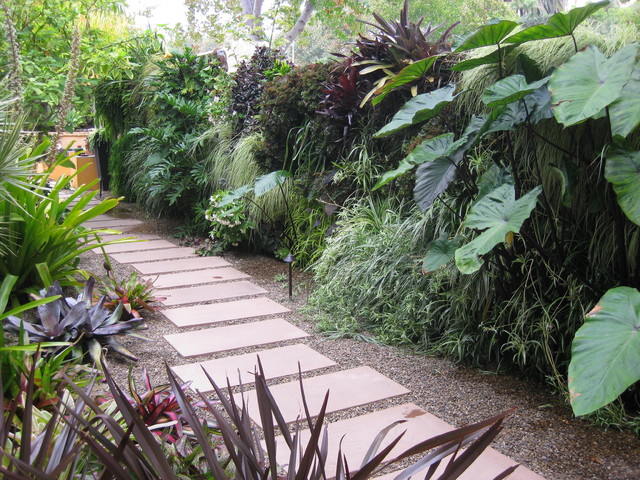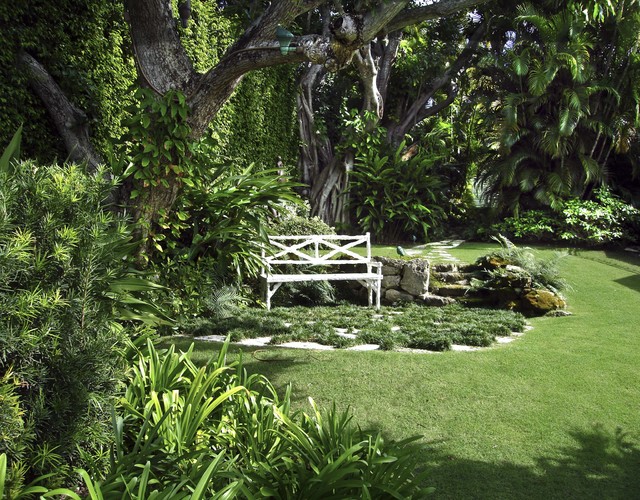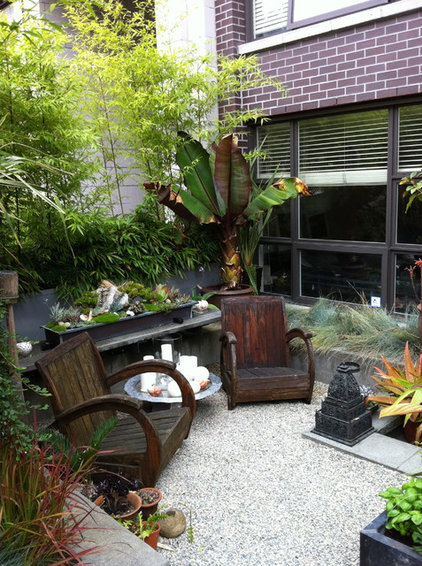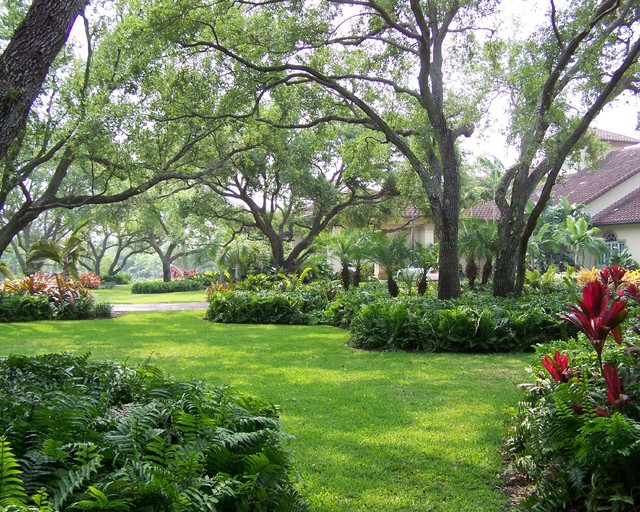
Choose colorful plants. This planting of caladiums and variegated ginger is an excellent example of how a landscape design of tropical bulbs can brighten up dark areas of yoour Gainesville lawn. Here the bulbs have been allowed to mix with other plantings of coarse textured plants such as Aztec Grass and Evergreen Giant Liriope, giving the appearance of a colorful landscape.
Tropical shade-tolerant plants can still be planted in August in Gainesville, whereas other areas of the country have to wait until Spring.
 by Amelia B. Lima & Associates »
by Amelia B. Lima & Associates »
Make gloomy areas of your Gainesville lawn enticing. Side yards are often overlooked in the landscape as areas of little potential, and are relegated to service tasks such as storing trash/recycle bins, compost heaps and other eyesores. Side yards in the shade can look even more depressing with little grasss or attention.
To make things interesting, plant tough plants like elephant ears or winter-dormant plantings, like shampoo ginger, with its bright red cones held aloft by tall stalks in late summer and fall. These and other bulbs can be left in the ground year-round as well. Gainesville flagstone walkways and hardscapes are perfect for side yards as well to make it easier for service such as taking the bins to the street for their weekly pick up as you see in the Gainesville hardscape walkway photo above.
 by Jeff Blakely,ASLA »
by Jeff Blakely,ASLA »
Replace grass with shade-tolerant groundcovers. Gainesville sod and other local turfgrasses can have a hard time growing in the shade, but low-maintenance ground covers combined with stepping stones make an excellent alternative. Their deep green and finely textured foliage also makes the perfect backdrop for bold and leafy tropical plants. The mondo grass in this photo makes an excellent lawn replacement for shadier spots and remains evergreen through winter, too. Liriope and ferns are also good choices for a finely textured ground cover that can take over an unmanageable area to give it some texture and interest.
 by Glenna Partridge Garden Design »
by Glenna Partridge Garden Design »
Use small spaces wisely. A lot of times, it's the smallest Gainesville landscape spaces that are the most poorly lit and designed, whether adjacent walls, trees or tall buildings are at fault. The upsides to cramped areas like the courtyard shown here are that they're easily tended to and often have their own protected microclimate, making them ideal for growing whatever you want (within reason) throughout the year.
When using tropical plants in small spaces, a little goes a really long way. Don't add too many plants too fast, since many will quickly outgrow their space and require trimming or division to keep them from making the garden seem even more compact. A little goes a long way in a compact area with healthy soil. Start with a solid backbone of hardy evergreen shrubs and ground covers and an inviting paved area so that visitors (and yourself) can enjoy the Gainesville patio. Then bring out the big guns.
 by Raymond Jungles, Inc. »
by Raymond Jungles, Inc. »
Use texture. Many gardeners grow tropical plants for their color, but you must not overlook the dramatic and architectural textures that they lend to the gainesville landscape as well.
The philodendron is a great shade-tolerant landscape plant for Gainesville lawns, while the larger-leaved palm trees can be replaced with cold-hardy types, like windmill palm or needle palm for our area.
 by orlando comas, landscape architect. »
by orlando comas, landscape architect. »
Control your shade. There's a big difference between the gentle and airy shade provided by the live oaks shown here and the mixed light on the side of a house that abruptly shifts between full shade and direct sun throughout the day. You can control the amount of shade by planting new trees for more shade or let in more light by hiring a local Gainesville tree company to thin branches and remove any undesirable trees that are blocking too much sunlight.
Beware of trees marketed as fast growing, as they're often too fast for their own good and plague homeowners with brittle limbs, messy seeds and invasive roots such as Sweetgums, Cherry Laurels, or Raintrees. Instead, choose trees that you wouldn't mind seeing for many years to come.
